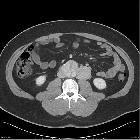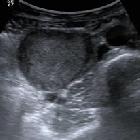organ of Zuckerkandl





The organ of Zuckerkandl comprises of a small mass of chromaffin cells derived from neural crest located along the aorta, beginning cranial to the superior mesenteric artery or renal arteries and extending to the level of the aortic bifurcation or just beyond. The highest concentration is typically seen at the origin of the inferior mesenteric artery.
Physiology
Its physiological role is thought to be of greatest importance during the early gestational period as a homeostatic regulator of blood pressure, secreting catecholamines into the fetal circulation. The organ regresses at the end of gestation and following birth to form the aorticosympathetic group of the adult paraganglia.
Radiographic features
The organs of Zuckerkandl are not often visualized radiologically unless they are involved in a pathologic process, including:
History and etymology
It was first described in 1901 by Emil Zuckerkandl (1849-1910) , a professor of anatomy at the University of Vienna.
Siehe auch:
- Neuroblastom
- Paragangliom
- Phäochromozytom
- Arteria mesenterica inferior
- chromaffin cells
- extraadrenal pheochromocytoma based in organ of Zuckerkandl
- Paragangliom des Retroperitoneums
und weiter:

 Assoziationen und Differentialdiagnosen zu Zuckerkandl-Organ:
Assoziationen und Differentialdiagnosen zu Zuckerkandl-Organ:




